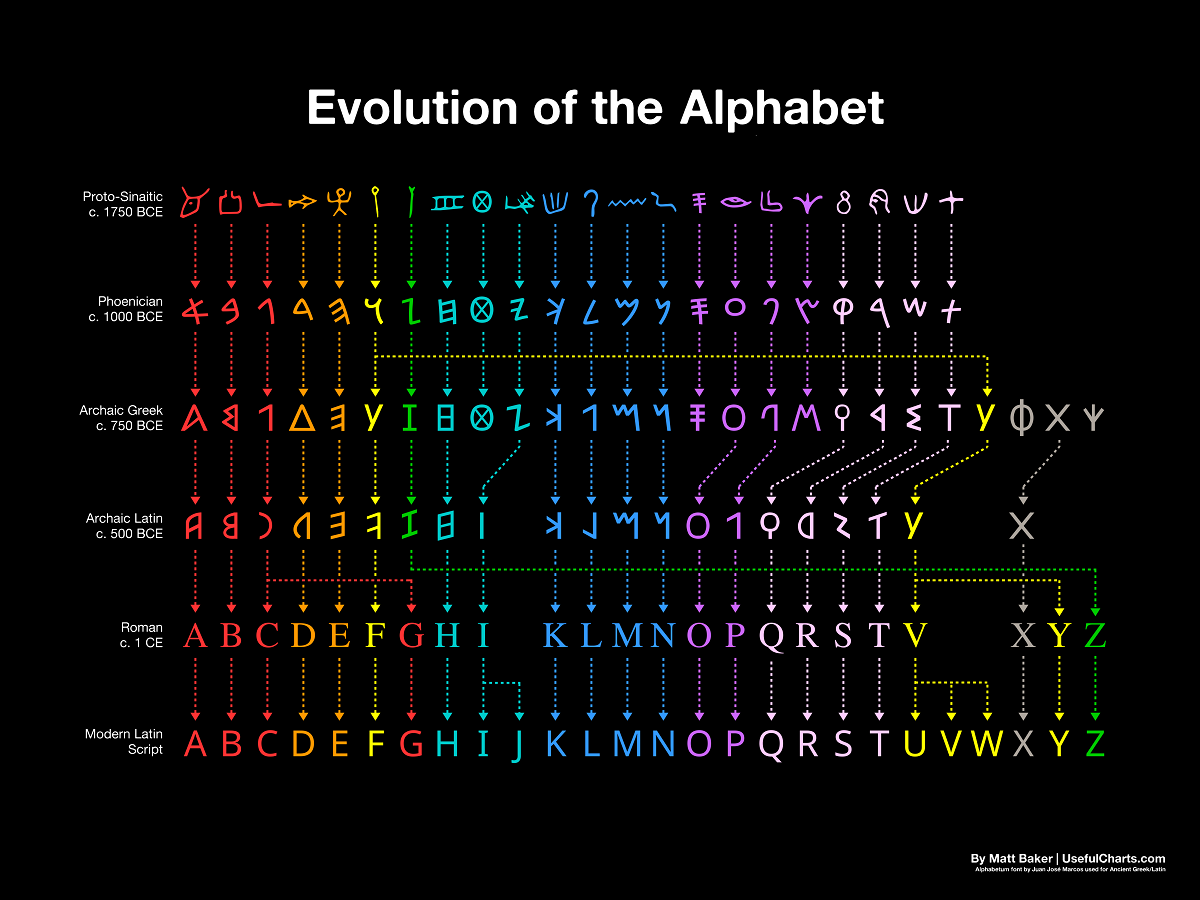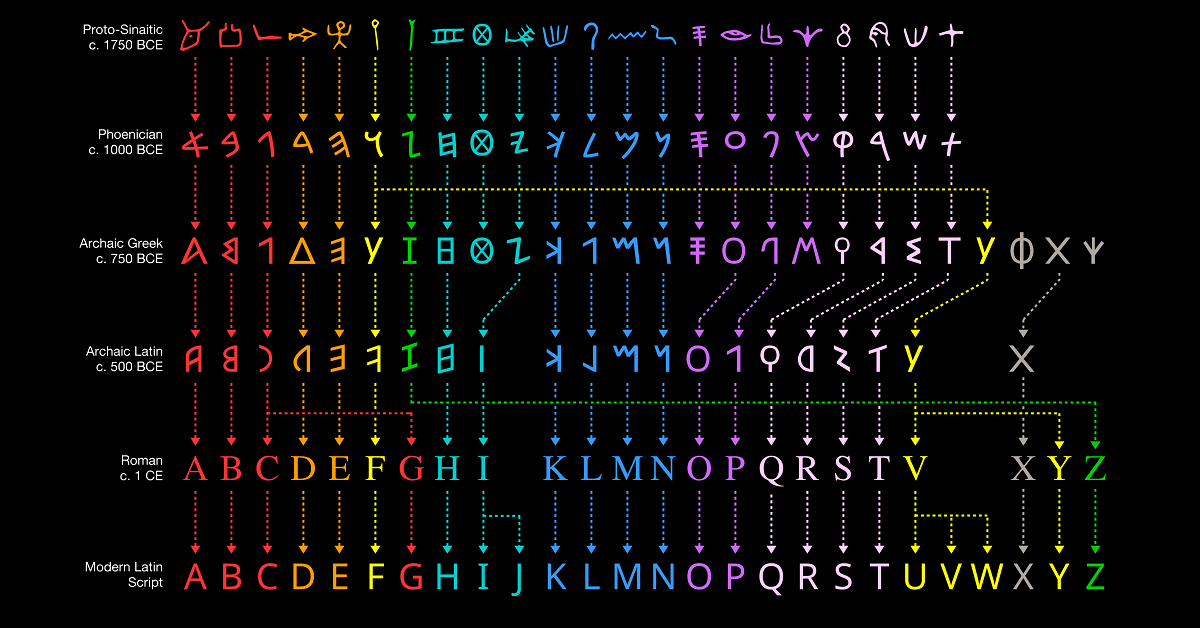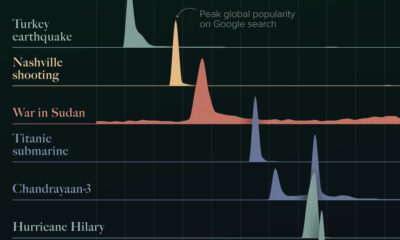Misc
From Greek to Latin: Visualizing the Evolution of the Alphabet

From Greek to Latin: Visualizing the Evolution of the Alphabet
Over the course of 2021, the Greek alphabet was a major part of the news cycle.
COVID-19 variants, which are labeled with Greek letters when becoming a variant of concern, normalized their usage. From the Alpha variant in the UK, to the Delta variant that spread from India to become the dominant global strain, the Greek alphabet was everywhere. Seemingly overnight, the Omicron variant discovered in South Africa has now taken the mantle as the most discussed variant.
But the Greek alphabet is used in other parts of our lives as well. For example, Greek letters are commonly used in mathematics and science, like Sigma (Σ) denoting a sum or Lambda (λ) used to represent the half-life of radioactive material.
And the study of linguistics shows us why using Greek letters in English isn’t completely farfetched. This visualization from Matt Baker at UsefulCharts.com demonstrates how the modern Latin script used in English evolved from Greek, and other, alphabets.
It’s All Proto-Sinaitic to Me
Before there was English, or Latin, or even Greek, there was Proto-Sinaitic.
Considered the first alphabet ever used, the Proto-Sinaitic script was derived in Canaan, around the biblical Land of Israel. It was repurposed from Egyptian hieroglyphs that were commonly seen in the area (its name comes from Mount Sinai), and used to describe sounds instead of meanings.
| Proto-Sinaitic Letter (Reconstructed Name) | Original Meaning |
|---|---|
| ʾalp | ox |
| bayt | house |
| gaml | throwstick |
| dag | fish |
| haw/hillul | praise |
| waw/uph | fowl |
| zayn/zayt | oxhide ingot/sword |
| ḏiqq | manacle |
| ḥaṣr | courtyard |
| ḫayt | thread |
| ṭab | good |
| yad | hand |
| kap | palm |
| lamd | goad |
| maym | water |
| naḥaš | snake |
| ṡamk | peg |
| ʿayn | eye |
| ġabi | calyx |
| pʿit | corner |
| ṣaday | plant |
| qoba | needle/nape/monkey |
| raʾš | head |
| šimš | sun |
| śadeh | field |
| ṯann | bow |
| tāw | mark |
As the first Semitic script, Proto-Sinaitic soon influenced other Semitic languages. It was the precursor to the Phoenician alphabet, which was used in the area of modern-day Lebanon and spread across the Mediterranean and became the basis for Arabic, Cyrillic, Hebrew, and of course, Greek.
Evolving into the Greek, Roman, and Latin Alphabets
Over time, the alphabet continued to become adopted and evolve across different languages.
The first forms of the Archaic Greek script are dated circa 750 BCE. Many of the letters remained in Modern Greek, including Alpha, Beta, Delta, and even Omicron, despite first appearing more than 2,500 years ago.
Soon the Greek alphabet (and much of its culture) was borrowed into Latin, with Archaic Latin script appearing circa 500 BCE. The evolution into Roman script, with the same recognizable letters used in modern English, occurred 500 years later in 1 CE.
| Alphabet | Usage (Year) |
|---|---|
| Proto-Sinaitic | ~ 1,750 BCE |
| Phoenician | ~ 1,000 BCE |
| Archaic Greek | ~ 750 BCE |
| Archaic Latin | ~ 500 BCE |
| Roman | ~ 1 CE |
| Modern Latin | Today |
Many of the letters which first came from Egyptian hieroglyphs made their way into modern English, but they took a long and convoluted journey. As the graphic above highlights, some letters evolved into multiple forms, while others fell out of use entirely.
And this is just a snapshot of the many scripts and languages that the modern English alphabet evolved from. Lowercase letters came from Roman cursive, which evolved into the Insular and Carolingian scripts before becoming modern lowercase English.
Like many things in the long arc of human culture, alphabets are not as far removed from each other as you might think.
VC+
VC+: Get Our Key Takeaways From the IMF’s World Economic Outlook
A sneak preview of the exclusive VC+ Special Dispatch—your shortcut to understanding IMF’s World Economic Outlook report.

Have you read IMF’s latest World Economic Outlook yet? At a daunting 202 pages, we don’t blame you if it’s still on your to-do list.
But don’t worry, you don’t need to read the whole April release, because we’ve already done the hard work for you.
To save you time and effort, the Visual Capitalist team has compiled a visual analysis of everything you need to know from the report—and our upcoming VC+ Special Dispatch will be available exclusively to VC+ members on Thursday, April 25th.
If you’re not already subscribed to VC+, make sure you sign up now to receive the full analysis of the IMF report, and more (we release similar deep dives every week).
For now, here’s what VC+ members can expect to receive.
Your Shortcut to Understanding IMF’s World Economic Outlook
With long and short-term growth prospects declining for many countries around the world, this Special Dispatch offers a visual analysis of the key figures and takeaways from the IMF’s report including:
- The global decline in economic growth forecasts
- Real GDP growth and inflation forecasts for major nations in 2024
- When interest rate cuts will happen and interest rate forecasts
- How debt-to-GDP ratios have changed since 2000
- And much more!
Get the Full Breakdown in the Next VC+ Special Dispatch
VC+ members will receive the full Special Dispatch on Thursday, April 25th.
Make sure you join VC+ now to receive exclusive charts and the full analysis of key takeaways from IMF’s World Economic Outlook.
Don’t miss out. Become a VC+ member today.
What You Get When You Become a VC+ Member
VC+ is Visual Capitalist’s premium subscription. As a member, you’ll get the following:
- Special Dispatches: Deep dive visual briefings on crucial reports and global trends
- Markets This Month: A snappy summary of the state of the markets and what to look out for
- The Trendline: Weekly curation of the best visualizations from across the globe
- Global Forecast Series: Our flagship annual report that covers everything you need to know related to the economy, markets, geopolitics, and the latest tech trends
- VC+ Archive: Hundreds of previously released VC+ briefings and reports that you’ve been missing out on, all in one dedicated hub
You can get all of the above, and more, by joining VC+ today.
-

 Travel1 week ago
Travel1 week agoAirline Incidents: How Do Boeing and Airbus Compare?
-

 Markets2 weeks ago
Markets2 weeks agoVisualizing America’s Shortage of Affordable Homes
-

 Green2 weeks ago
Green2 weeks agoRanked: Top Countries by Total Forest Loss Since 2001
-

 Money2 weeks ago
Money2 weeks agoWhere Does One U.S. Tax Dollar Go?
-

 Misc2 weeks ago
Misc2 weeks agoAlmost Every EV Stock is Down After Q1 2024
-

 AI2 weeks ago
AI2 weeks agoThe Stock Performance of U.S. Chipmakers So Far in 2024
-

 Markets2 weeks ago
Markets2 weeks agoCharted: Big Four Market Share by S&P 500 Audits
-

 Real Estate2 weeks ago
Real Estate2 weeks agoRanked: The Most Valuable Housing Markets in America















